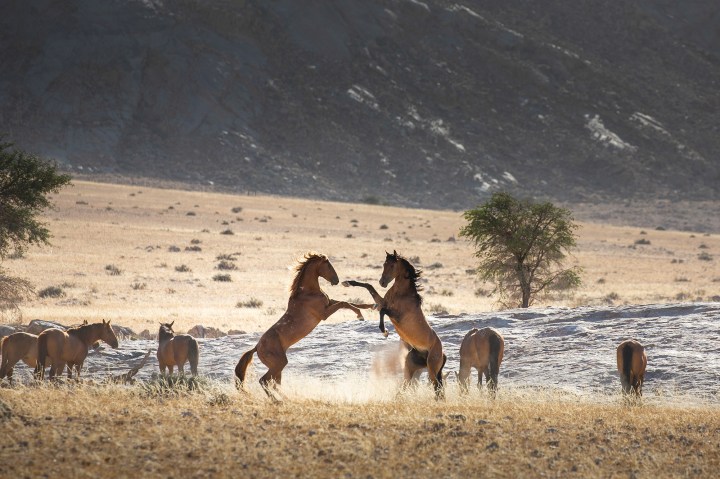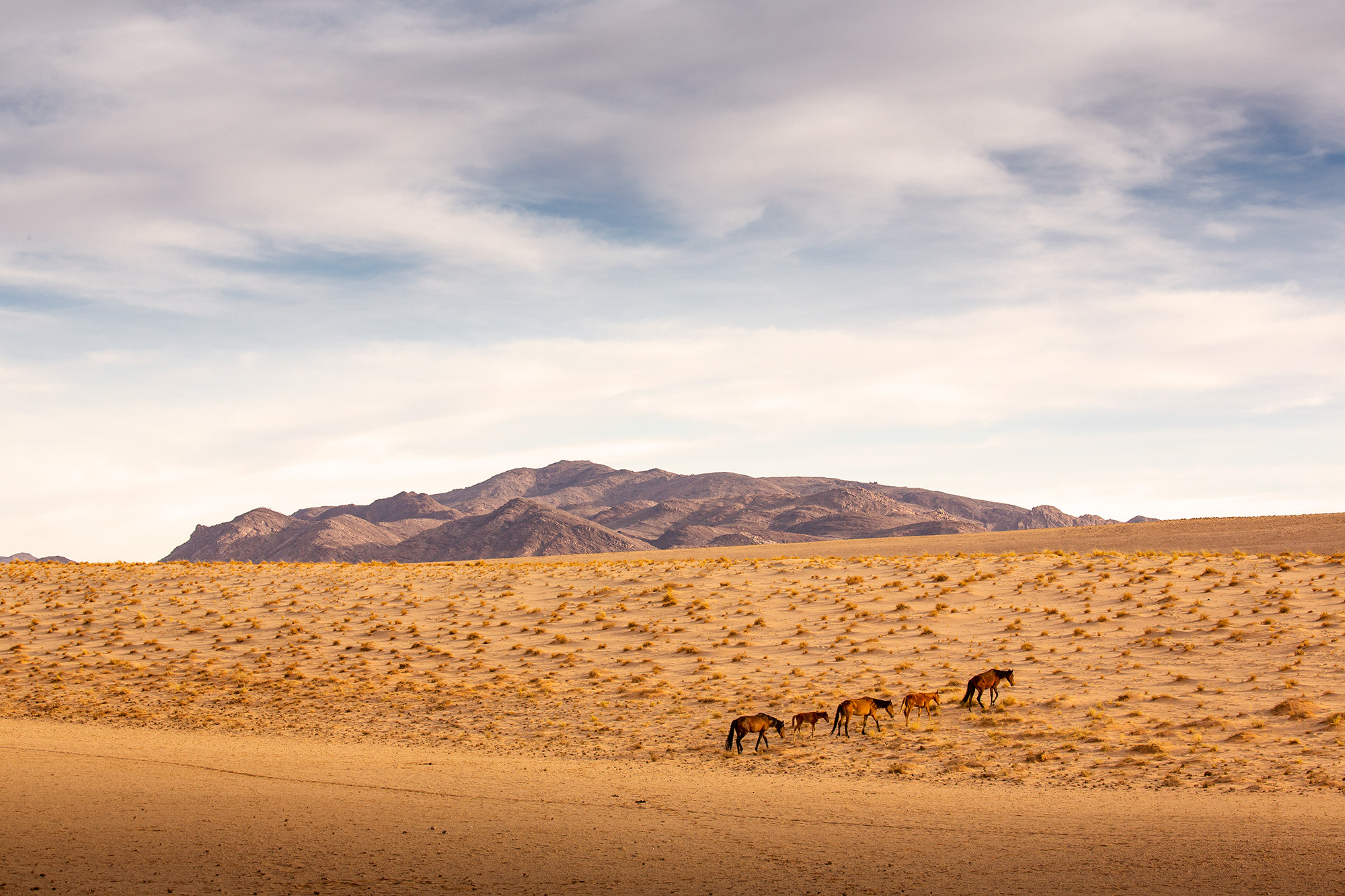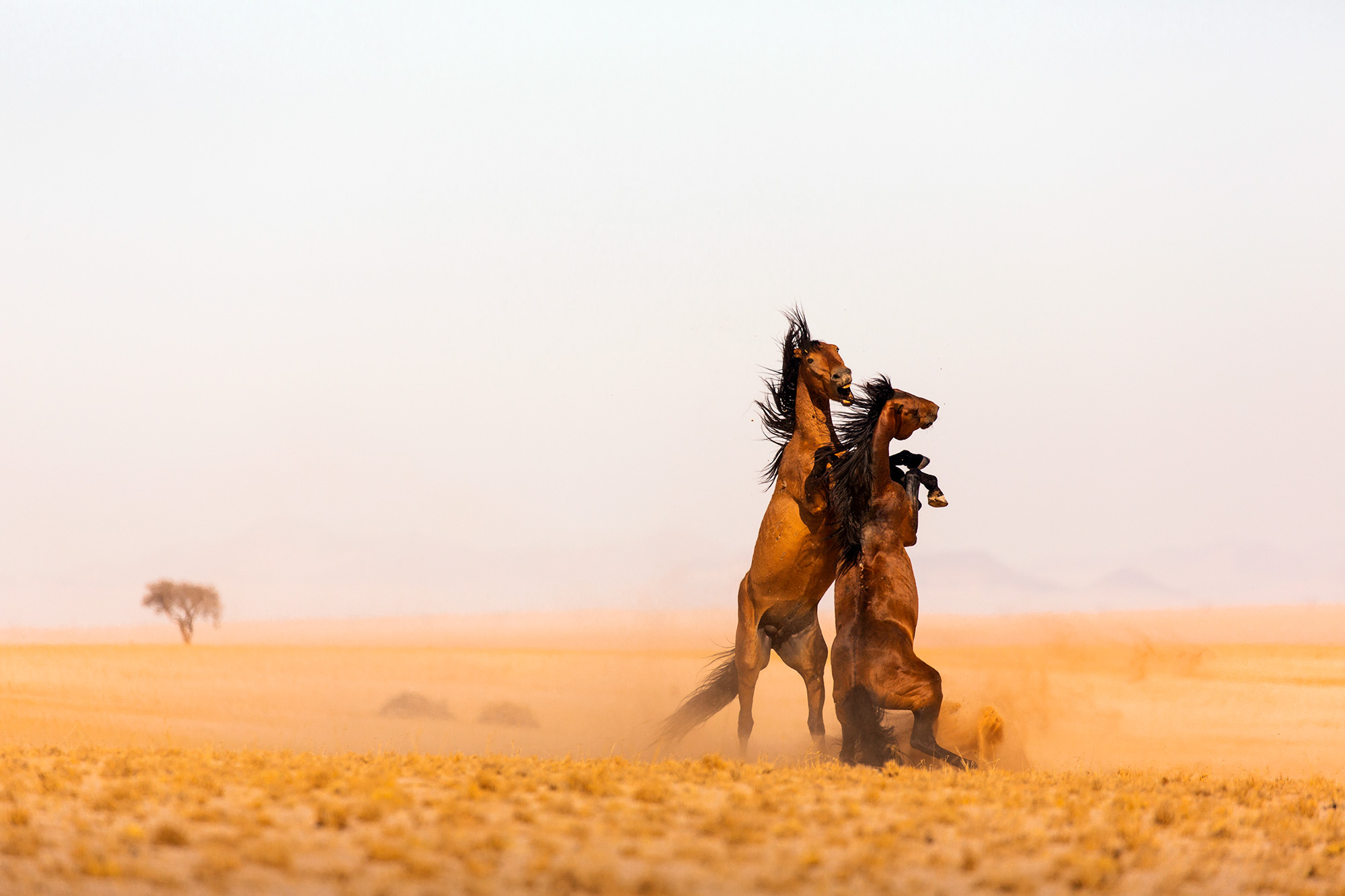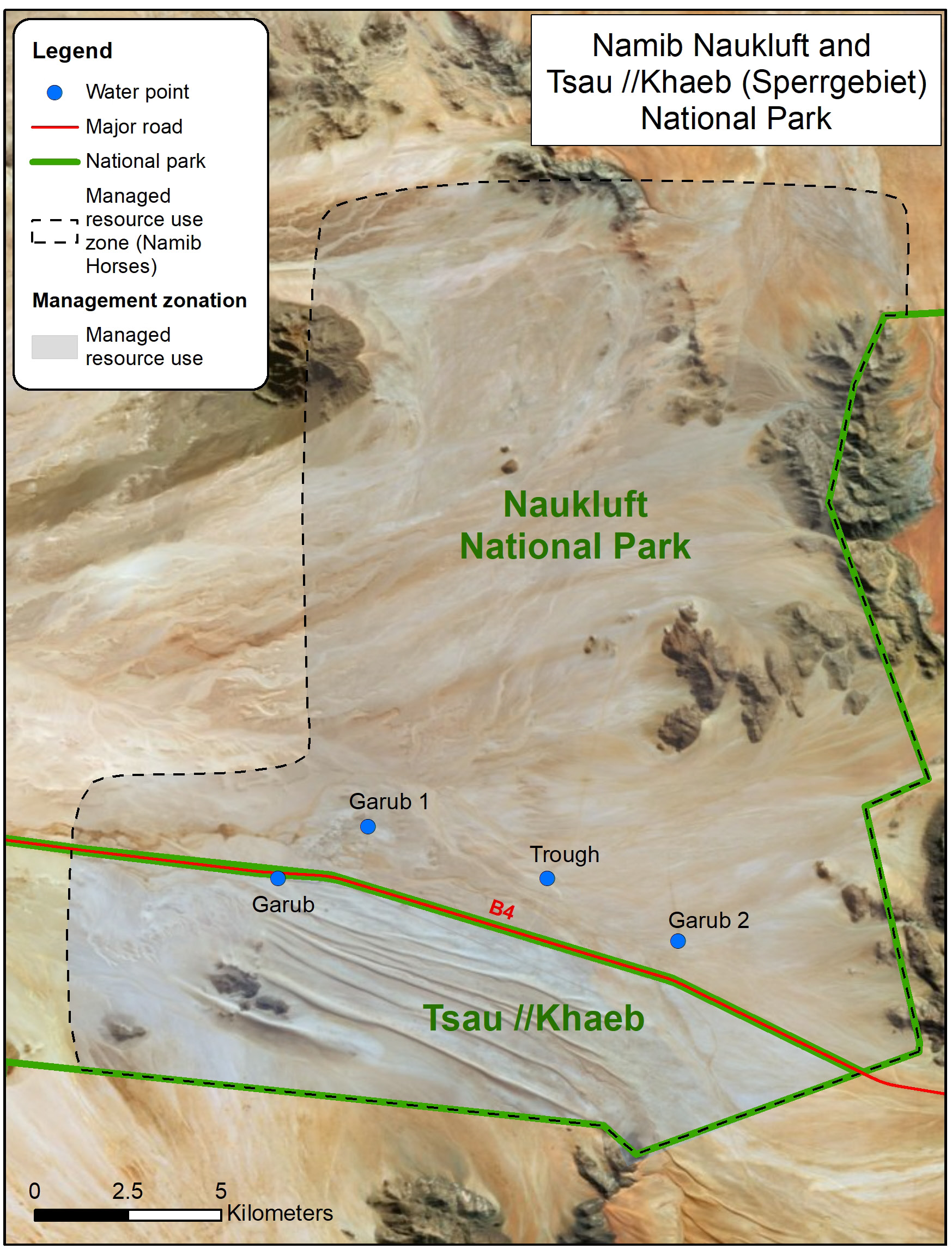MAVERICK LIFE
Wild steeds of the great Namib desert

One might expect to see a gemsbok, a jackal or even a springbok on the trackless plains and dunefields of the great Namib Desert. But a horse?...
All photographs by Teagan Cunniffe.
It had the makings of a joke, crouching beside a drinking trough in the blistering Namib Desert waiting for a horse. What eluded me was the punch line. After half an hour it wasn’t even remotely funny.
On every side, the bare gravel plain rippled skywards in shimmering mirages, broken only by the black ramparts of a dormant volcano named Dik Willem. There was no way, on that featureless terrain I could approach the Namib’s skittish wild horses. The only sensible plan had been to wait for them to become thirsty enough to head for the water piped in by park officials. Some binocular work had suggested dots on the horizon were, indeed, horses and that they seemed to be heading my way. So I hunkered down, camera in hand, feeling like a loaf in an oven. And waited.
In the deep silence, the soft plop of a hoof was clearly audible. I didn’t dare peer over the low stone wall separating the drinking troughs for fear of startling the scout stallion. He suddenly loomed round the wall, huge, chestnut and decidedly wild-looking. Seeing me, he threw his head up and snorted. I didn’t move and looked down, trying to appear non-threatening. Then he backed off behind the wall and I heard slurping.
Soon the rest of the group arrived, each eying me owlishly but not taking fright. I slowly raised my camera. At the soft click of the shutter every horse in sight jerked its head up and seemed ready to take off: in the silence of the great desert small sounds clearly carried great portent. Maybe it reminded them of a rifle bolt sliding into place. But my second shot raised less interest, and soon they tolerated my camera’s attention.

A Clear Victor, by Teagan Cunniffe

Dune Crossing, by Teagan Cunniffe
They were large, long-limbed beasts, these survivors in a place where logic suggests no horse should be; thin but otherwise in good condition. There was evidence of some nasty battles, however: hacked ears, kick marks on their sides and bites on their withers. Their hooves, also, were chipped from the harsh desert gravels.
But all is not well. After a century of freedom, their population is dropping because spotted hyenas have become adept at picking off the foals and, occasionally, an adult. The problem is that spotted hyenas are endangered in Namibia and the horses are not indigenous.
For many years the presence of these feral horses was not widely known, their range falling within the Sperrgebiet – the forbidden zone in which diamonds are mined. Where they come from is a mystery with many theories, though most people agree they have been there since “German times” (before 1919).
One theory has to do with a cargo steamer loaded with thoroughbreds which escaped when it ran aground near Luderitz. Another is that they’re descendents of Nama horses brought into the area at the beginning of the 20th century.

Bachelor Standoff, by Teagan Cunniffe
A rather more romantic tale concerns an eccentric German nobleman, Baron Hansheinrich von Wolf, who built a castle named Duwisib on the edge of the desert. He imported some fine horses from Europe and bred stallions for the German military Schutztruppe patrolling the Sperrgebiet and protecting natural springs near Garup and Aus. When war was declared in 1914, the baron joined up and was killed in Europe, leaving some 300 horses round the castle to their own fate.
A Namibian management plan for the horses suggests they originated from the Kubub stud farm that was established south-east of Aus in 1912 by the mayor of Lüderitz, Emil Kreplin, who bred horses for the racetrack and working horses for the diamond mines. In World War I he was interned and later repatriated to Germany. Unattended and with no fences to constrain them, the abandoned horses made their way to Garub, 30 kilometres away.
Horses are hardy creatures and, since the Lower Eocene Period some 55-million years ago, have wandered the plains of Europe, Asia, Africa and, later, America. But for centuries – until the invention of the internal combustion engine – they were too useful to be left to wander unharnessed. The last truly wild horses were Equus przewalskii which thundered across the icy Mongolian plains a hundred years ago. Equus caballus – the standard issue horse – has been fully domesticated for maybe 5,000 years.
But give it a gap and a domestic mount will take to living wild like a duck to water. All it needs is grazing and water. In the Namib Desert, on the face of it, these things are in short supply.

The area in which the horses live consists of gravel slope, dune sand, tough calcium carbonate-permeated crust and a hard stony layer known as desert pavement. In a good year perhaps 40 millimetres of rain falls. Still, some grass does grow.
For many years the Namib’s feral horses survived on natural springs, supplementing water intake from the Garub rail siding where a borehole was dug in 1908 to serve the now-defunct steam trains. When the springs dried up and the station closed down, De Beers Diamond Mines installed a drinking trough for the horses. It’s now their sole water supply, but today is maintained by officials of the Namib Naukluft Park.
A study of the horses done by Telané Greyling of Potchefstroom University shows just how adaptable they can be. She found their diet included a range of tough grasses as well as some desert shrubs and twigs – all of which added up to around seven kilograms of nosh a horse a day, about the same as any pampered pony.
It’s just that it takes a whole lot longer and far harder work to get what they need. So they sleep less: around four hours a day instead of the normal horsy seven. Hardly surprisingly, they spend most of their time grazing: far longer than their green-field cousins. They also play less (even the foals), walk slower to conserve energy and have little time for comfort activities such as rubbing, rolling or even yawning. The stallions posture more and fight less than domestic horses, though when they do fight it’s all gnashing teeth, flying hooves and dust.
Much of their energy is taken up trekking long distances between grazing and the water point, so the horses have found a solution. They can easily go for up to 72 hours without a drink (the longest time recorded by Greyling was four days).
They also eat dry dung (it’s named coprophagy) for the simple reason that, despite having passed through a horse, it still has a higher and more concentrated energy content than the surrounding grass.
The horses I came across looked in fine shape, but the desert takes its toll. Greyling found that an average of around four in 10 foals died not long after birth. The causes included predation by jackals, hyenas or possibly even leopards, nutritional stress, getting left behind because of worn-down hoofs and just plain exhaustion from walking too far. Occasionally one wandered onto the almost dead-straight road between Aus and Luderitz and was hit by a vehicle.
There is, of course, a question that needs asking about the feral horses of the Namib. Should they be there at all? Horses are not part of the native wildlife and must surely be competing with oryx, springbok and steenbok in the area.
There are those who argue that the horses are of historical and scientific value and a great tourist attraction. Others say they should be left to fight for their own survival without human intervention. Conservation purists would have them removed. If they were trucked out and domesticated, the horses would probably soon die, having developed no natural immunity to viral infections.
Those who would like to see the horses remain in the Namib could claim that the creatures are merely returning to an area in which their ancestors once ran wild. Three-toed, horse-like creatures known as hipparians would probably have left their bones beneath the desert sands.
But that would have been maybe five million or more years ago. So, genetically speaking, the present steeds have a very slender claim on grounds of succession.
A better argument is the historical one. For around 100 years, with no murmur from a conservationist, the Namib horses have adapted to their environment with only a little help from their friends. For these refugees from human misadventure and neglect it’s been a heroic struggle. In the process – if you’ll excuse the expression – they’ve certainly earned their desert spurs, not to mention a right to our respect.
And there is about a horse, something of the flightiness of Pegasus, the raw power of the Centaur, the ethereal beauty of the unicorn and the wildness of Poseidon’s wave steeds. But these are all mythical. The wild horses of the great Namib Desert are real.
The puzzle about what to do with the desert horses led to a management plan with guidelines for the survival of both horses and hyenas. It recognises the horses for their value for both tourism and as part of Namibia’s cultural heritage. They are provided with supplementary feeding and a water supply. But with few foals their future looks precarious. Some hyenas were shot, but this led to a local outcry. Relocation? Maybe.
I’d been crouching beside the water trough for long enough to develop a painful cramp in one leg. When I judged the horses had drunk enough I stood up – which resulted in a thunder of hooves as they galloped back into the shimmering desert, long manes and tails streaming.
There are few sights more stirring than wild steeds flying across a fence-free plain. If the only place they can do that is in an unwanted desert, it seemed to me, then let it be. DM/ ML














 Become an Insider
Become an Insider
Thanks for nice article and the super pictures. I stop off there every year with my motorcycle tours and have noticed that they are no as wild anymore with lots of them coming right up to the cars and people at the view point. Tourists are feeding them apples which must be a real treat for them
What a joy to read an intriguing and insightful article about the natural world which provides a calming and re-assuring release from the ubiquity of covid, State Capture and Trump. Please encourage Don to do so more regularly.
I spent 6 months as an army conscript in the Namib and went back to Luderitz and Maltahohe and across to Walvis on a memory trip in 1968 before I left for university in England. I loved the desert’s open expanses and silence but had never heard of the feral horses surviving in the desert. There are feral horses all over the world (the USA, Australia, Hungary to name three countries) and they are controversial in the three identified countries mostly because they are not native/natural. In all three countries, contraception projects have been proposed (and there are contraceptives that can be administered remotely by dart that are safe and effective) but in Australia and the USA are largely opposed or inadequately implemented by the responsible agency. The authorities usually claim that it is impossible to get close enough to dart such wild and skittish creatures despite the fact that concerned amateurs have successfully contracepted specific populations with minimal support from the authorities. Meanwhile, the US budget to “manage” the wild horse herds has grown from around $15 million to over $80 million as has the wild horse population in the US. Sounds like a successful government project don’t you think?